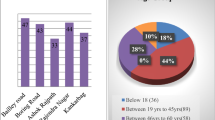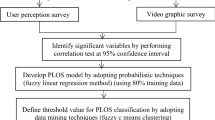Abstract
This study aims at developing a model for pedestrian to evaluate service measure at the roadside walking environment from the qualitative and quantitative analysis in developing countries. The potential primary factors influencing service measure of pedestrian were summarized taking consideration to heterogeneous traffic flow condition and perception of road users. Total 735 real-time sense of participant’s satisfaction when they are using the sidewalks, road geometric as well as operational characteristics of the road segments were collected from the 73 sites. The selected sites belong to midsized cities with varying geometric features. Different statistical investigations like factor analysis, Wilks’ lambda test and stepwise regression analysis were carried out to develop PLOS model for sidewalk facilities. From the results it has been observed that the variables taken such as width of sidewalk, vehicle volume, pedestrian volume etc. are significantly influencing the pedestrian service measure and the model was validated with a significance value of R2= 0.972. The PLOS scores got from the model are then classified using Genetic Programming clustering to find the six PLOS ranges (A-F) which show score for PLOS A ≤1.8 with best condition and PLOS F > 5.1 having worst condition of service.
Similar content being viewed by others
References
Bian, Y., Wang, W., Lu, J., Ma, J., and Tan, D. (2007). “Pedestrian level of service for sidewalk in China.” Transportation Research Board, Washington, D.C., pp. 1–23.
Highway Capacity Manual (2000). Transportation Research Board, Washington, D.C.
Highway Capacity Manual (2010). Transportation Research Board, Washington, D.C.
Jaskiewicz, F. (2000). “Pedestrian level of serv ice based on trip quality.” Transportation Research Board, Washington, D.C., pp. 1–14.
Khisty, C. J. (1994). “Evaluation of pedestrian facilities, beyond the level-of-service concept.” Transportation Research Record, Washington, D.C., Vol. 1438, pp. 45–50.
Koza, J. R. (1992). “Genetic programming: On the programming of computers by means of natural selection.” A Bradford book, MIT press, Cambridge, Massachusetts, London, England.
Landis, B. W., Vattikuti, V. R., Ottenberg, R. M., McLeod, D. S., and Guttenplan, M. (2001). “Modeling the roadside walking environment: A pedestrian level of service.” Transportation Research Board, Washington, D.C., Vol. 1773, pp. 1–27, DOI: 10.3141/1773-10.
Lautso, K. and Murole, P. (1974). “A study of pedestrian traffic in Helsinki: Methods and Results.” Traffic Engineering and Control, Vol. 14, No. 9, pp. 446–449.
Miller, J. S., Biglow, J. A., and Garber, N. J. (2000). “Calibrating pedestrian level-of-service metrics with 3-D visualization.” Transportation Research Record, Washington, D.C., Vol. 1705, pp. 9–15, DOI: 10.3141/1705-02.
Muraleetharan, T. and Hagiwara, T. (2007). “Overall Level-of-Service of the Urban Walking Environment and Its Influence on Pedestrian Route Choice Behaviour: Analysis of Pedestrian Travel in Sapporo, Japan.” 86th Annual meeting of Transportation Research Board, Washington, D.C., pp. 1–16, DOI: 10.3141/2002-02.
Prassas, E. S., Roess, R. P., and Mcshane, W. R. (1996). “Cluster analysis as tool in traffic engineering.” Transportation Research Record, Washington, D.C., Vol. 1551, pp. 39–48, DOI: 10.3141/1566-05.
Romero, C., Espejo, P.G., Zafra, A., Raul, J. R., and Ventura, S. (2013). “Web Usage Mining for predicting final marks of students that use moodle courses.” Computer Application Engineering Education, Wiley Periodicals. Vol. 21, No. 1, pp. 135–146, DOI: 10.1002/ cae.20456.
Sarkar, S., (1993). “Determination of service levels for pedestrians, with european example.” Transportation Research Record, Washington, D.C., Vol. 1405, pp. 35–42.
Author information
Authors and Affiliations
Corresponding author
Rights and permissions
About this article
Cite this article
Sahani, R., Ojha, A. & Bhuyan, P.K. Service levels of sidewalks for pedestrians under mixed traffic environment using Genetic Programming clustering. KSCE J Civ Eng 21, 2879–2887 (2017). https://doi.org/10.1007/s12205-017-0042-y
Received:
Revised:
Accepted:
Published:
Issue Date:
DOI: https://doi.org/10.1007/s12205-017-0042-y




